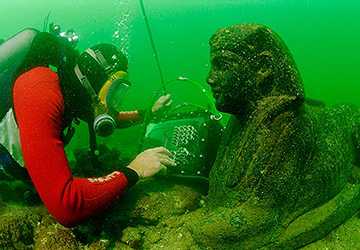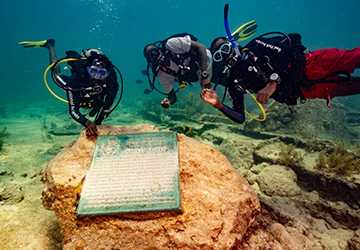Exploring underwater ruins presents a sui generis opportunity to delve into antiquity. From archaic metropolises submerged beneath the ocean to shipwrecks narrating chronicles of maritime escapades, diving for underwater history proffers an unrivalled vista into yesteryears. Whether you're a veteran diver or a history lover, these underwater ruins will surely enrapture your imagination.

Diving for underwater history offers an immersive odyssey that amalgamates the exhilaration of exploration with the allure of unearthing historical relics. Underwater ruins dive locales are dispersed globally, each with distinctive narrative and enigmas awaiting elucidation. These submerged historical sites provide a rare chance to observe how antecedent civilizations thrived, functioned, and entertained, all amidst the serenity of the marine abyss.
1. Port Royal, Jamaica: Dubbed the "wickedest city on Earth" during the 17th century, Port Royal was a teeming pirate sanctuary before an earthquake in 1692 decimated it. Today, divers can traverse this once-infamous city's submerged avenues and towers, making it a quintessential location for an underwater ruins dive.
2. Alexandria, Egypt: The underwater city of Alexandria ranks among the most eminent historical diving sites globally. Home to the illustrious Lighthouse of Alexandria, one of the Seven Wonders of the Ancient World, this site offers an enthralling plunge into the core of ancient Egyptian civilization.
3. Baiae, Italy: Once an opulent resort for Roman aristocrats, the city of Baiae now reposes beneath the waters of the Bay of Naples. Divers can explore the well-preserved ruins of this ancient city, including mosaics, statues, and thermal baths, making it an impeccable spot for diving for underwater history.
4. Yonaguni Monument, Japan: This enigmatic underwater edifice has incited debate among archaeologists and divers alike. Some posit it to be the vestiges of an ancient civilization, while others contend it is a natural formation. Nonetheless, the Yonaguni Monument remains among the most beguiling historical diving sites.
5. Pavlopetri, Greece: Regarded as one of the oldest submerged cities worldwide, Pavlopetri dates back to 2800 BCE. The well-preserved ruins of this ancient city afford a captivating glimpse into early Greek civilization, making it a must-visit for any underwater ruins dive enthusiast.
In addition to submerged metropolises, shipwrecks offer another exhilarating facet of diving for underwater history. These historical diving sites frequently teem with marine biodiversity, augmenting the dive's splendour.
SS Thistlegorm, Egypt: This World War II cargo vessel was sunk by German bombers in 1941 and now rests at the Red Sea's nadir. Divers can explore the ship's cargo, which includes trucks, motorcycles, and wartime supplies, making it a captivating underwater ruins dive.
- RMS Rhone, British Virgin Islands: This British mail ship sank during a hurricane in 1867 and is now among the Caribbean's most frequented dive sites. The wreck is home to many marine life and offers a distinctive opportunity to dive into history.
- USS Kittiwake, Cayman Islands: This former US Navy ship was intentionally submerged to create an artificial reef. Now, it serves as a popular site for diving for underwater history, allowing divers to explore its various compartments and observe the marine life that has colonized it.
While historical diving sites offer phenomenal opportunities for exploration and education, it's imperative to approach these underwater ruins with deference and care. Divers must adhere to guidelines that safeguard these fragile sites from degradation. By doing so, we ensure that future generations can continue to savour the wonders of diving for underwater history.
- Preservation Efforts: Many underwater ruins dive sites are protected by statutes and regulations to thwart looting and deterioration. Divers should be aware of and comply with these rules to help conserve these historical treasures.
Responsible Diving: Avoid touching or disturbing the ruins and marine life. Employ buoyancy control to avert accidental contact with the site. This helps to sustain the integrity of the historical diving sites and the delicate ecosystems encircling them.
- Supporting Conservation: Consider endorsing organizations devoted to preserving underwater ruins and marine environments. These entities labour indefatigably to protect these invaluable sites for posterity.
Preparation is paramount for those poised to embark on their quest of diving for underwater history. Here are some tips to ensure a triumphant and pleasurable dive:

- Research: Acquaint yourself with the historical diving sites you intend to visit. Comprehending the history and significance of these underwater ruins will enhance your diving experience.
- Certification and Training: Ensure you possess the requisite diving certification and training for the dive site. Some underwater ruins dive locations may necessitate advanced skills due to depth, currents, or other factors.
- Equipment: Utilize high-calibre diving gear and ensure it's well-maintained. Consider bringing an underwater camera to document your adventure, but remember to prioritize the site's preservation over capturing the perfect shot.
- Respect the Environment: Abide by all guidelines and regulations established by local authorities and dive operators. Respect the underwater ruins and the marine life inhabiting them.
Underwater ruins dive sites unearth vestiges of bygone epochs and concealed troves that have reposed undisturbed for aeons. These troves range from quotidian artefacts to invaluable relics, offering a palpable nexus to antiquity.
- Historical Significance: Dwarka, conjectured to be the ancient dominion of Lord Krishna, has been the locus of myriad archaeological inquiries. The submerged ruins, located off the coast of Gujarat, comprise intricate edifices and potential remnants of antediluvian habitations, rendering it an indispensable historical diving site.
Artifacts Unearthed: Aquanauts have exhumed pottery, sculptures, and architectural relics indicative of an advanced civilization. These discoveries have enriched India's historiographical narrative.
- Eerie Beauty: Lake Reschen, renowned for the solitary church steeple protruding from its waters, conceals the vestiges of villages inundated to form the reservoir. This underwater ruins dive provides a spectral yet captivating exploration of submerged domiciles and thoroughfares.
- Submerged Structures: Aquanauts can traverse the eerily preserved remnants of Curon, witnessing firsthand the ramifications of the anthropogenic inundation on these historical settlements.
- Ancient Commerce Hub: Once a bustling emporium, Heracleion now lies beneath the Mediterranean Sea. Its submerged ruins, encompassing colossal statues and intact temples, afford a glimpse into its erstwhile grandeur as a commercial and sacrosanct nucleus.
- Diverse Finds: Artifacts such as numismatic specimens, weights, and bronze effigies have been exhumed, making Heracleion a bounteous site for those diving for underwater history.
Diving for underwater history is a thrilling and educational experience that allows us to connect with the past uniquely. From ancient cities to sunken ships, historical diving sites offer a glimpse into the lives of those who came before us. By approaching these underwater ruins dive sites with respect and care, we can ensure their preservation for future generations.